REPORT ON UPGRADE ON SOLAR-POWER AND COMPUTER LAB EXPANSION
IN LA’ANGUM LEARNING CENTRE (LLC) IN BUMBOAZIO
Bumboazio is a non-electrified community a few kilometers from Langbinsi in the East Mamprusi District of northern Ghana. This community has a school that was been founded and is managed by PAMBE Ghana, a non-profit organization (NGO).
Jak Solar Technologies, a Solar Business entity based in Tamale, was contracted to expand and rehabilitate the existing solar system in the La’angum Learning Centre. The overall assignment was to
a.) re-design, upgrade, procure and install a 3.2kWp solar system of the school computer laboratory, library and Upper Elementary Block and,
b.) rehabilitate the existing DC system for the Lower Elementary Block.
EXISTING SYSTEM
This was made up of twelve 50-watt panels (600Watt peak) system designed to generate about 3,910KWh in a day, depending on the sun.
This typically was to run 10 laptop computers with a one-day autonomy since it is a school. It also included ten 9-watt bulbs in the computer lab as well as security lighting around the lab.
The school also had three separate 100-Watt DC (Direct Current) for lighting in the class rooms and outside for security.
THE NEW SYSTEM
RE-DESIGNING, UPGRADING, PROCURING AND INSTALLING A 3.2KWP SOLAR SYSTEM OF THE SCHOOL COMPUTER LABORATORY, LIBRARY AND UPPER ELEMENTARY BLOCK.
The new system is design to provide power for up to two projectors, 30 laptop computers, 30 AC (Alternating Current) lighting for the computer lab, library, security lights and for all the classrooms on the Upper Elementary Classroom Block.
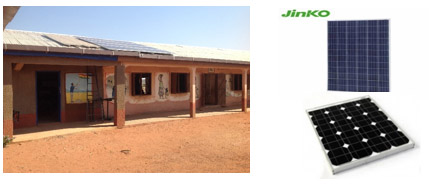
Solar Power for the Computer Lab and Lighting
The system is made up of 20 pieces of 50watt peak (total 1kWp) panels and 8 pieces of 275watt peak (total 2.2kWp) of Solar panels. Total installed capacity is 3.2kWP (3200 kilo watt peak). The solar panels are mounted on the roof of the building, at the same tilt angle and orientation as the building facing south.
The 20 pieces of the 50watt peak (1kWp) is connected to a controller and six of the 275watt Peak (1.65kWp) is connected to the Growatt 3kva inverter charger Controller 1, and the remaining two (2) 275watt peak (0.55watt peak) is also connected to Controller 2 above.
This forms a 3.2kWp generator which can produce 19200Kwh of power a day considering maximum sunshine of 6 hours a day.
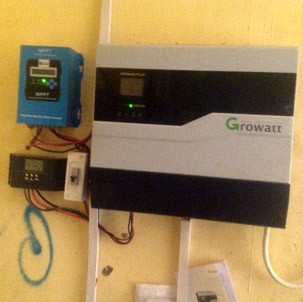
The Inverter
The battery bank is made up of four number 200ah deep cycle batteries connected in series to form a battery bank. This number of batteries was arrived at considering the fact that most of the load (about 90%) will be run during the day when the sun is still available.
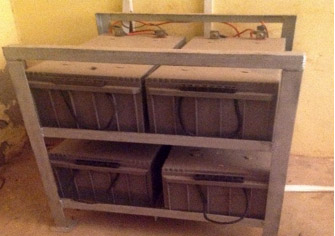
The Battery Bank
The selected inverter is hybrid, Growatt 3kVA storage plus. This allows the client or customer to select which power source should be used first, in terms of Battery, Solar or Grid (where Grid is available).
The inverter is programmed for Solar panel/energy to supply power to the load is first priority, and if the energy from the solar is not sufficient to power all connected load, battery energy will supply power to the load at the same time with the solar panels.
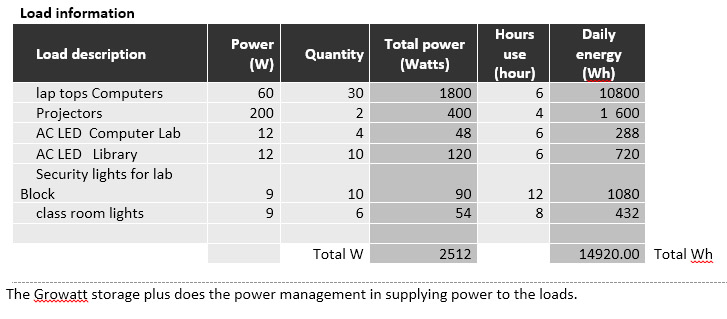
Loads
The expected load to connect to the system is 14920wh in a day. Table above are details of the load.
Operations and Maintenance
In comparison with other types of electrical power plants, PV plants require less maintenance.
The inverters are the most critical components and they tend to be the cause of most major outages in a PV plant. However, inverter technology has improved significantly over the past few years and typical failures, if they occur, often happen during commissioning or very early in the life of the plant and are thus within the warranty period.
Besides scheduled maintenance for inverters, the other activities include periodic washing of the modules and unscheduled maintenance activities, which require minimal staffing.
There are no emissions associated with solar PV systems during operations.
REHABILITATING THE EXISTING DC SYSTEM FOR THE LOWER ELEMENTARY BLOCK
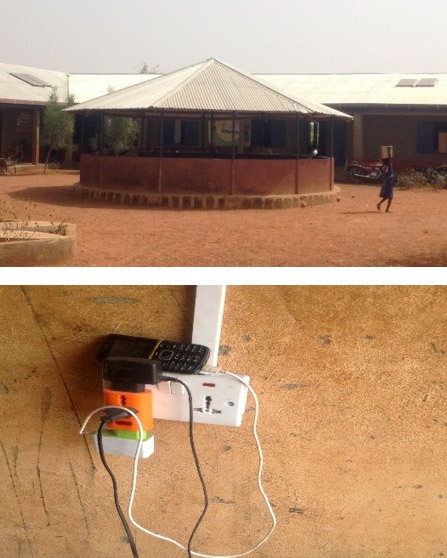
Eight pieces of 255-watt solar PV panels and eight additional 50-watt solar PV panels were procured and added to the existing twelve 50-watt panels. The new system produces about 1,840Wh a day, depending on the availability of the SUN.
- The AC System
Each classroom is provided with a socket outlet (15 points in all) to enable the use of a laptop in the classrooms.
- The DC System
The three separate 100-Watt solar panels were brought together to supply 20 DC (Direct Current) lighting points for the Lower Elementary Classroom Block.
CONCLUSION
The system was successfully installed and Is performing within expectations.
As time goes by, Jak Solar Tech is willing to assist with further studies and analysis of the system.
Please find below the resizing reports for the School PV system
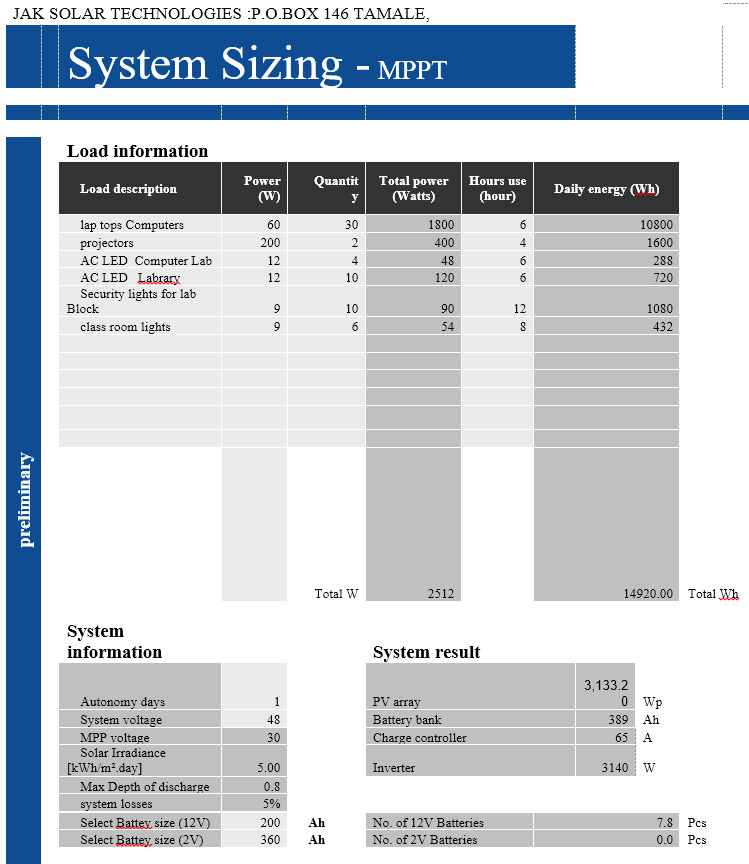
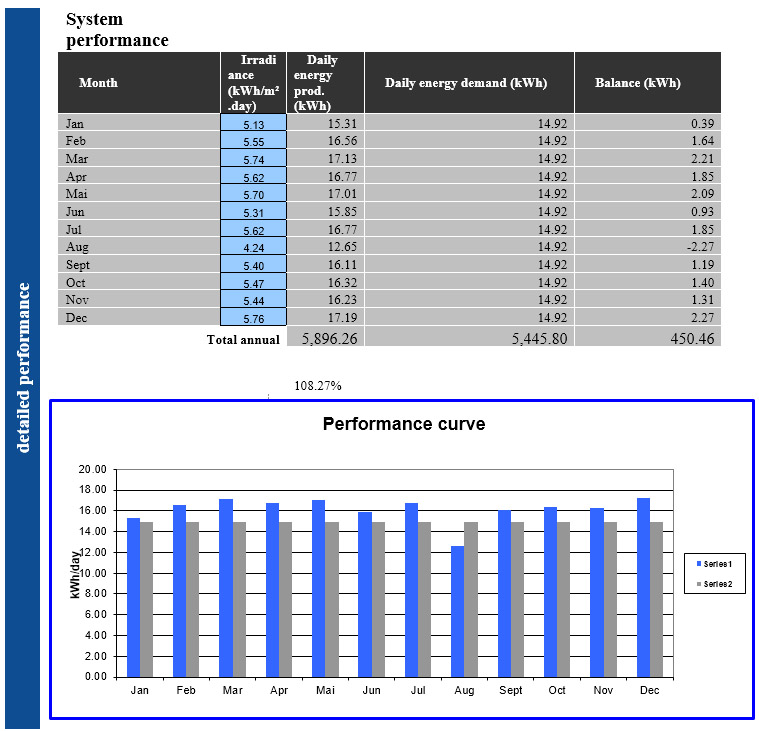
COMPUTERS AND OTHER EQUIPMENT
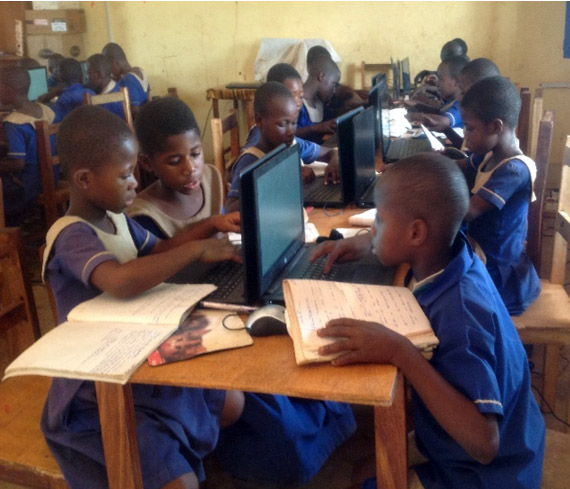
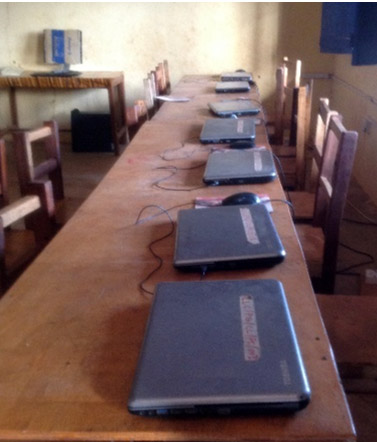 We acquired 20 new laptop computers (HP), 20 computer mouses and one complete desktop computer to be used mainly as a teaching aid. I did some research on laptops versus desktops for a computer laboratory, given that the GES ICT curriculum and assessments are based on the desktop. Power consumption was the deciding factor. A desktop needs 2-3 times the amount needed for a laptop! They also need to be plugged in at all times in order to work. Laptop computers are obviously, more suitable for our solar-powered computer lab.
We acquired 20 new laptop computers (HP), 20 computer mouses and one complete desktop computer to be used mainly as a teaching aid. I did some research on laptops versus desktops for a computer laboratory, given that the GES ICT curriculum and assessments are based on the desktop. Power consumption was the deciding factor. A desktop needs 2-3 times the amount needed for a laptop! They also need to be plugged in at all times in order to work. Laptop computers are obviously, more suitable for our solar-powered computer lab.
We now have 26 laptop computers and one desktop in the computer lab. We will donate one of the Toshiba laptops to Unity JHS. With this number of computers, the whole class of 35-40 students can be together for a lesson!
We also purchased two important pieces of equipment; a Canon photocopier/printer with 4 toners, and an Optiva HIFI Speaker System, with two microphones.
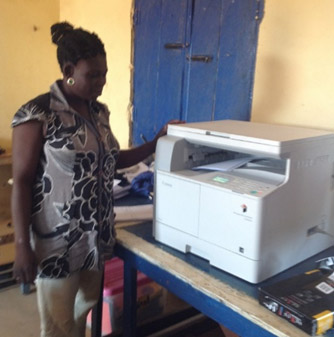 The photocopier/printer, though much more costly than a printer, it is much more economical for printing and photocopying in the long run. It is easy to operate and requires very little maintenance, and toners are much cheaper than cartridges for photocopying.
The photocopier/printer, though much more costly than a printer, it is much more economical for printing and photocopying in the long run. It is easy to operate and requires very little maintenance, and toners are much cheaper than cartridges for photocopying.
Thus, it is more suited for heavy-duty copying in school.
The only downside is that it only makes black and white copies. Luckily, we have a 3-in-all printer for color printing, scanning and copying, if need be.
Optiva HIFI Speaker System is a Public Address System (PAS) we have needed for a long time in the school. Over the years, we have had to hire an often ineffective one from the community for events in the school. Our new PAS arrived in time to be baptized on our Independence Day celebration on March 6th, 2019!
Additionally, we got 20 chairs for our well-deserving teachers instead of a new projector and screen to replace our very old projector.
We are very grateful for the support we continue to receive from the Milburns Charitable Fund at the Oklahoma City Community Foundation. Thank you!
Prepared by
Alice Azumi Iddi-Gubbels
